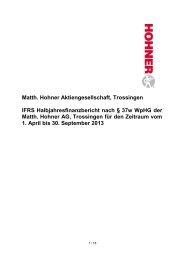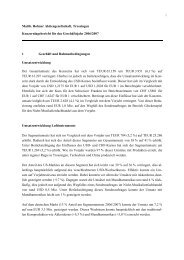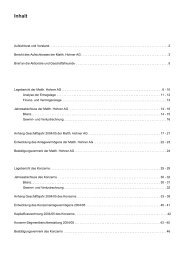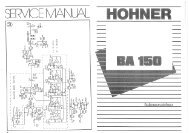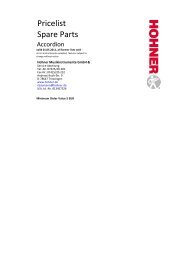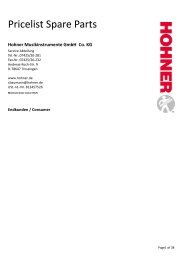Matth. Hohner AG
Matth. Hohner AG
Matth. Hohner AG
Create successful ePaper yourself
Turn your PDF publications into a flip-book with our unique Google optimized e-Paper software.
Notes to the Consolidated Financial Statements for Business Year 2010/2011<br />
Consolidation principles<br />
The consolidated financial statement includes the financial statement of the <strong>Matth</strong>. <strong>Hohner</strong> Aktiengesellschaft<br />
and its subsidiaries of March 31 of each business year. The financial statements of the subsidiaries and the<br />
associate companies are generally prepared of the same balance sheet date as of the parent company;<br />
Shanghai Lansheng-<strong>Hohner</strong> Musical Instruments Co., Ltd., Shanghai/China, which is included at equity with<br />
a balance sheet date at December 31 because it is not possible to prepare interim financial statements with<br />
appropriate effort is an exception.<br />
Subsidiaries will be totally consolidated starting from the acquisition date, which means at the moment in which<br />
the Group gains the control.<br />
The equity holding in the consolidated financial statement ends, as soon as the control by the parent company<br />
does no longer exist.<br />
The actual value method takes place by offsetting the acquisition cost with the Groups’ interest of the fair<br />
value of the identifiable assets, debts and contingent liabilities of the subsidiary at the acquisition date<br />
(purchase method).<br />
The consideration for an acquisition is defined by the sum of the offered assets at the acquisition date current<br />
fair value and the received or assumed liabilities in replacement of the control of the acquired company.<br />
If applicable, the consideration for an acquisition includes any assets and debts resulting from a contingent<br />
consideration arrangement. The contingent consideration is valued by fair value at the acquisition-date.<br />
Subsequent changes of these fair values will be adjusted against the acquisition costs, as long as it deals with<br />
the correction within the assessment period. All other changes of the fair value as asset or as debt classed as a<br />
contingent consideration will be accounted according to the respective IFRS.<br />
If the initial accounting for a business combination is incomplete by the end of the reporting period in which the<br />
combination occurs, the Group reports in its financial statements provisional amounts for the items for which<br />
the accounting is incomplete. During the measurement period, the Group retrospectively adjusts the provisional<br />
amounts recognized at the acquisition date to reflect new information obtained about facts and circumstances<br />
that existed as of the acquisition date and, if known, would have affected the measurement of the amounts<br />
recognized as of that date.<br />
The measurement period is the space from the acquisition date till the date in which the Group obtained full<br />
information about facts and conditions of the acquisition date, however the measurement period not exceed<br />
one year from the acquisition date.<br />
The goodwill which occurs at a merger is recognized at the date of control. It complies the surplus of the sum<br />
of the transferred consideration, the value of all non-controlling interest in the acquiree and the prior buyer’s<br />
fair value of the equity in the acquiree (if given) and the net of the existing amounts of the acquired identifiable<br />
asset values. If the acquisition costs exceed the fair values of the acquired identifiable assets, debts and<br />
contingent liabilities, a goodwill will be accounted among the intangible assets. The goodwill will be subjected<br />
to an annual impairment test (Impairment-only-Approach). If acquisition costs are lower than fair values of the<br />
acquired identifiable assets, debts and contingent liabilities, the net will promptly accounted yield effectively.<br />
All intercompany balances, transactions, incomes, expenses, profits and losses from intercompany transactions<br />
which are contained in the book value of assets are fully eliminated.<br />
Accounting and valuation policies<br />
Estimates and assessments by management<br />
For the preparation of the consolidated financial statements, estimates and assumptions had to be made,<br />
which effect on recognition and measurement in the balance sheet and the profit- and loss statement or the<br />
statement of comprehensive income. In spite of careful estimation, the actual realized amounts could differ to<br />
the made assumptions. Estimations are especially required in:<br />
• The impairment tests of intangible and tangible fixed assets, inventories, credits<br />
and accounts receivables,<br />
• The determination of the expected useful economic life of capital assets,<br />
• The measurement of the feasibility of differed tax assets,<br />
• The recognition and the measurement of the pensions, the provisions and other accruals.<br />
The estimates were made on the basis of experiences and other relevant factors under consideration of the<br />
going concern principle. All estimates and assumptions were made with best knowledge. The assumptions are<br />
constantly reviewed in order to minimize false estimations.<br />
The examination of the goodwill the cash-generating units and other requires basically the estimation of<br />
future cash flows as well as their discounting. The estimations are forecasts based on the financial planning of<br />
the management.<br />
Other significant premises are discount factors as well as tax rates. A change of these factors may lead to<br />
impairments.<br />
Asset depreciation ranges are determined consistently across the group based on intercompany table of<br />
the asset depreciation range. All asset depreciation ranges are annually examined and may be modified if<br />
necessary. The actual useful economic life can differ from the forecasted.<br />
Deferred taxes of loss carry forwards are estimated on the basis of the prospective feasibility of tax benefits.<br />
The real fiscal profit situation in prospective periods and the real usability of loss carry forwards can be<br />
differing from the estimation at the date of activation of deferred taxes. The measurement of accruals<br />
is depending on the actual business case. Also it can be partly complex and considerable involved with<br />
estimations.<br />
Management’s assumption concerning the occurrence as well as the possible level of the real availment based<br />
among other things to experience values, estimates and discount factors. The real availment can differ from<br />
the recognition of the accruals insofar.<br />
Notes to the CoNsolidated FiNaNCial statemeNts Notes to the CoNsolidated FiNaNCial statemeNts<br />
69



